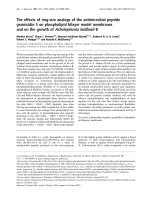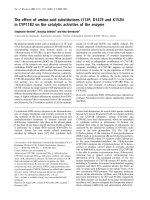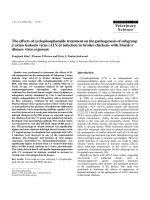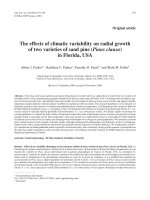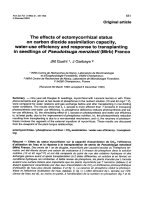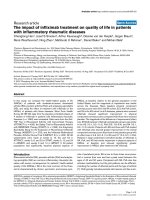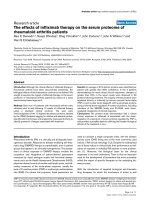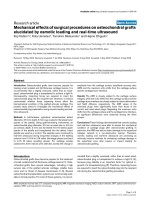Báo cáo y học: "The effects of cognitive-behavioural therapy on mood-related ruminative response style in depressed adolescents" pdf
Bạn đang xem bản rút gọn của tài liệu. Xem và tải ngay bản đầy đủ của tài liệu tại đây (309.9 KB, 10 trang )
BioMed Central
Page 1 of 10
(page number not for citation purposes)
Child and Adolescent Psychiatry and
Mental Health
Open Access
Research
The effects of cognitive-behavioural therapy on mood-related
ruminative response style in depressed adolescents
Paul O Wilkinson* and Ian M Goodyer
Address: Section of Developmental Psychiatry, Department of Psychiatry, University of Cambridge, Cambridge, UK
Email: Paul O Wilkinson* - ; Ian M Goodyer -
* Corresponding author
Abstract
Background: A mood-related ruminative response style increases the risk of onset and
persistence of depression. This preliminary study investigated whether, in depressed adolescents,
cognitive-behaviour therapy reduces mood-related ruminative response style. Whether specific
factors within the rumination scale were differentially affected by CBT is also reported.
Methods: 26 depressed adolescents were randomised to receiving serotonin-specific reuptake
inhibitor antidepressants (SSRI) plus psychosocial treatment as usual or SSRI and psychosocial
treatment as usual plus CBT. Ruminative response style and depressive symptoms were measured
at baseline and after 30 weeks of treatment, with the Responses to Depression Questionnaire and
Mood and Feelings Questionnaire.
Results: There were significantly greater reductions in ruminations in the CBT group compared
to the non-CBT group (p = .002). There was no significant difference in the reduction in self-
reported depressive symptoms between the groups. Rumination was reduced to levels of never-
depressed controls in adolescents who had recovered from depression and received CBT. There
were greater falls in the CBT group in the more pathological 'brooding' factor of rumination.
Conclusion: These findings suggest that adding CBT to SSRI medication in the presence of active
clinical care causes a greater reduction in mood-related ruminative response style in depressed
adolescents. This may reduce the risk of future relapse.
Trial registration: Current Controlled Trials ISRCNT83809224.
Background
Mood-related response style
The degree to which a person, when dysphoric, focuses
attention on his or her symptoms, and the 'potential
causes, implications and consequences of these symp-
toms', is referred to as mood-related ruminative response
style (MRRS) [1]. It has been hypothesized that this mood
activated or 'hot' thinking style is a component of cogni-
tive vulnerability for the onset of clinical depression. Four
possible pathological mechanisms have been suggested
[2]: inappropriately using negative thoughts and memo-
ries to understand current circumstances; ruminative
thoughts interfering with and diminishing problem-solv-
ing; ruminative thoughts interfering with and restricting
the use of adaptive behaviour; if people ruminate and talk
a lot about these ruminations, other people may find this
wearisome and so be less likely to provide social support.
Published: 29 January 2008
Child and Adolescent Psychiatry and Mental Health 2008, 2:3 doi:10.1186/1753-2000-2-3
Received: 1 November 2007
Accepted: 29 January 2008
This article is available from: />© 2008 Wilkinson and Goodyer; licensee BioMed Central Ltd.
This is an Open Access article distributed under the terms of the Creative Commons Attribution License ( />),
which permits unrestricted use, distribution, and reproduction in any medium, provided the original work is properly cited.
Child and Adolescent Psychiatry and Mental Health 2008, 2:3 />Page 2 of 10
(page number not for citation purposes)
The Response Style Questionnaire (RSQ) [3] was devel-
oped to measure MRRS. High scores, indicating greater
MRRS, predict longer and more severe episodes of dys-
phoric mood [3-5] and onset of a major depressive epi-
sode [6] in adults. High rumination is also associated with
increased future depressive symptoms [7,8] and depres-
sive episodes [9] in children and adolescents. In the latter
study [9], rumination was highly correlated with depres-
sive symptoms, and rumination predicted a persistent as
opposed to a remitting major depressive episode, but not
a remitting episode compared to no episode, when
depressive symptoms were controlled for [10]. Although
studies have not directly compared the effects of rumina-
tion in different age groups, it appears that rumination
has qualitatively similar adverse effects in adolescence and
adulthood.
Ruminating is significantly associated with neuroticism
[4,11], hopelessness [11], faulty attribution [11] and dys-
functional attitudes [11] in adults and neuroticism in ado-
lescents [12]. High rumination amplifies the effects of
actual:ideal discrepancy on depressive symptoms [13].
Rumination mediates the effects of the dysfunctional
thinking styles of internal, stable & global negative attri-
butions; dysfunctional assumptions; self-criticism; and
neediness on onset of a depressive episode over the fol-
lowing 2 1/2 years [6].
Preliminary evidence for a process independent of depres-
sive symptoms has been reported from the experimental
induction of ruminating thoughts. A ruminative proce-
dure (focusing on one's symptoms, emotions and one-
self) has been shown to worsen dysphoric mood in
depressed but not non-depressed adults [14]. An experi-
mental study demonstrated that high levels of trait rumi-
nation predicted reduction in positive affect after a task
designed to lead to failure, but only in the group that had
been trained to think abstractly about the causes, implica-
tions and consequences of situations (ie ruminate); and
not in the group that were trained to think about the con-
crete sensory details of events [15]. The implication of
these findings is that MRRS is a key component in ampli-
fying of dysphoric mood, particularly in individuals with
high levels of self-devaluative ideation and a tempera-
mental predisposition to emotional response to environ-
mental cues.
In view of the evidence of the harmful effects of rumina-
tion, it is important to identify treatments that reduce lev-
els of rumination in individuals who are depressed, or at
risk of depression. This study will investigate whether spe-
cific treatment reduces rumination.
Factor analysis of the response style questionnaire
As noted above, studies of ruminative thinking style have
traditionally used the Ruminative Responses sub-scale of
the RSQ [3]. It is possible that some items of the RSQ are
proxy measures of depressive symptoms, which may con-
found the findings that high rumination predicts depres-
sive symptoms. Factor analytic studies have been carried
out on the RSQ. Five studies have recruited adult commu-
nity samples [16-20]; two have recruited clinic samples of
depressed adults [11,21]; one study recruited a commu-
nity sample of adolescents [8]. Inspection of the factors
across these studies showed that the same items normally
loaded onto equivalent factors. In particular, a more path-
ological factor (often labeled 'brooding') has been found
in most studies, which contained items that were unlikely
to be influenced by levels of depressed mood; this factor
was more strongly associated with current and/or future
depressive symptoms than the other factors. This suggests
that that it may be inappropriate and inefficient to treat
the rumination subscale as unidimensional.
Cognitive-behavioural therapy
In the UK, cognitive-behavioural therapy (CBT) is a psy-
chotherapy recommended as a first-line treatment for
mild to moderate depression in children and adolescents
if routine psychosocial management is unsuccesful [22].
This treatment has multiple components, in particular it
aims to correct negative thinking styles that are liable to be
maladaptive, and in addition encourages positive behav-
iours as therapeutic distractors. Part of the treatment
encourages taking part in positive activities rather than sit-
ting alone, doing nothing, a time when negative and
ruminative thoughts may occur, worsening mood. Theo-
retically, this treatment should therefore lead to a reduc-
tion in ruminative response styles.
Studies in adolescents have demonstrated that CBT is
more effective than control treatments for adolescent
depression. However, more recent meta-analyses [23]
have shown smaller effect sizes than earlier ones [24,25],
suggesting that it may not be as effective as previously
thought. The largest CBT study to date in adolescents, the
Treatment for Adolescents With Depression Study (TADS)
[26] failed to show an advantage of CBT over placebo,
although combined antidepressant plus CBT treatment
was more effective than antidepressant alone at 12 weeks.
There was no difference between active treatments at 36
weeks.
A randomized controlled trial carried out in routine Eng-
lish National Health Service clinics and comparing serot-
onin specific reuptake inhibitor antidepressant (SSRI)
plus active psychosocial treatment as usual (TAU) against
SSRI and TAU plus CBT for severely depressed adolescents
demonstrated no advantage of adding CBT to treatment
Child and Adolescent Psychiatry and Mental Health 2008, 2:3 />Page 3 of 10
(page number not for citation purposes)
(Adolescent Depression Antidepressants and Psychother-
apy Trial, ADAPT [27]). These were similar to the results
of a similar study in the USA [28]. Lack of superiority in
these two more recent trials may reflect a greater level of
psychosocial intervention in the non-CBT group; possibly
non-specific psychological support is as effective as the
specific components of CBT. In all these trials the primary
outcome measure was current depressive symptoms or
levels of psychosocial impairment. The UK RCT provided
an opportunity to test the effects of CBT on the thinking
styles of depressed adolescents in this preliminary study
in a subset of the ADAPT participants.
Hypotheses
The primary hypothesis of this preliminary study was that
adding CBT to SSRI plus psychosocial treatment as usual
would cause greater reduction in rumination. If true then
some support is provided for CBT having particular posi-
tive effects on depressogenic cognitions that neither SSRI
nor active routine clinical care provide. A secondary
hypothesis was that rumination levels would be no differ-
ent to those of healthy controls among adolescents recov-
ered from depression (less than two depression symptoms
for at least 8 weeks [29]) who had received CBT. We fur-
ther hypothesized that CBT would have specific effects on
the ruminative factor of brooding but not on reflection (as
identified by Burwell and Shirk in adolescents [8]), as
brooding contains response styles that are likely to be
more maladaptive and increase the risk of depression, and
so more likely to be targeted by CBT. In addition, it is
probably more important to target brooding as reducing
brooding is more likely to reduce depressive symptoms,
concurrently and in future.
Methods
Participants
Depressed cases
Consecutive referrals to community child and mental
health clinics in Cambridge and Huntingdon who met eli-
gibility criteria were invited to take part in the Adolescent
Depression Antidepressants and Psychotherapy Trial
(ADAPT) and this study, the Thinking Styles Study. There
were fewer participants in this study than ADAPT, because
only Cambridgeshire participants were recruited, and
recruitment started later than the wider ADAPT study.
Inclusion criteria for being in both studies were: ages 11–
17 (inclusive); current DSM-IV major depressive disorder;
and evidence of social, family or school impairment.
Cases were excluded if they were too unwell for the treat-
ment study (in practice, this referred to patients who
required immediate antipsychotics or immediate admis-
sion – 2% of all depressed participants who were assessed
in both centres; suicidal thoughts or acts were not exclu-
sion criteria); had contraindications to SSRI use; had a sig-
nificant learning disability; if an organic cause for
depression, schizophrenia or bipolar disorder was present
(as determined by K-SADS-PL interview); subjects and/or
carers were unable to complete research questionnaires; a
history of epilepsy or other major neurological disease;
taking psychoactive drugs (prescribed or illicit), other
than antidepressants, which would be active at time of
interview (as elicited by K-SADS-PL interview and direct
questioning on recent drug use).
Controls
Healthy controls were recruited to demonstrate whether
rumination levels were similar to those of healthy con-
trols after CBT, or remained high. Control subjects were
recruited from two Cambridgeshire schools. Exclusion cri-
teria were: current diagnosis of mental illness as defined
in DSM-IV; lifetime history of major depressive disorder;
current severe psychosocial stress; current neurological
disorder; regularly taking psychoactive drugs (prescribed
or illicit) which would be active at time of interview (as
elicited by K-SADS-PL interview and direct questioning on
recent drug use); learning difficulties necessitating special
schooling; not speaking fluent English.
Measures
The Responses to Depression Questionnaire, RDQ, is a slight
modification of the original Response Styles Question-
naire (Nolen-Hoeksema & Morrow, 1991), with wording
of some items slightly modified to make it more appropri-
ate for adolescents [30]. It is a 39-item questionnaire ask-
ing participants what they habitually think, do or feel
when they experience low mood (not clinical depression).
There are 21 negatively worded rumination items. Past
research demonstrates good evidence for discriminant
validity and stability for the original questionnaire [3].
While stability has not been demonstrated for the adoles-
cent version, predictive validity for future depressive dis-
order and depressive disorder has been demonstrated [9].
Each item was scored from 0 to 3. Scores were obtained by
adding up the rumination items for total rumination
score; and by adding up the scores for all items within
each factor. 5 out of 6 items labeled as brooding (not
Think, "why do I have problems others don't?"), and all 4
items labeled reflection, in the Burwell and Shirk's study
[8], are present in the original version of the RDQ, as used
in this manuscript.
The Kiddie – Schedule for Affective Disorders and Schizophre-
nia – Present and Lifetime Version (K-SADS-PL) is a semi-
structured interview, which provides DSM-IV diagnoses,
with reliability proven in past research [31]. All screen sec-
tions were applied, and if screening was positive, the full
section was administered. In this study, agreement
between two independent raters was 100% for the diagno-
sis of major depression.
Child and Adolescent Psychiatry and Mental Health 2008, 2:3 />Page 4 of 10
(page number not for citation purposes)
The Mood and Feelings Questionnaire, MFQ [32] is a 33
item self-rated questionnaire of depressive symptoms and
was completed by all participants. It has good test-retest
reliability (ICC = 0.8, [33]; Pearson's r = 0.78, [34]). A cut-
off of 28/29 has been shown to optimally discriminate
adolescents with major depression from those with sub-
threshold depression or no depressive disorder [33].
The Raven's Standard Progressive Matrices, SPM, [35] was
designed as a test of eductive intelligence, the non-verbal
ability to identify, generate and manipulate new concepts.
It can be thought of as being related to performance IQ.
Eductive intelligence may affect ability of individuals to
utilise CBT successfully, and so between-group differences
may confound the results. There are 60 separate patterns
or sets of patterns, each with one piece missing; and six or
eight possible answers for each pattern, only one of which
is correct. The test was explicitly not timed, so that final
scores would reflect subjects' eductive abilities and not be
influenced by time pressures or processing speed. Raven's
SPM scores were transformed to age-scaled score bands
(higher bands represent higher intelligence; bands run
from 1 to 8; bands 4 and 5 are, respectively, the bands
below and above the 50
th
centile). Where participants'
ages were above the maximum ages for the oldest age
bands (up to 15 years, 8 months), they were scored as if in
the oldest age band.
Test procedure
After consent was obtained, participants were randomised
to a 28 week course of SSRI and active psychosocial treat-
ment as usual plus CBT (CBT group) or SSRI and active
psychosocial treatment as usual without CBT (TAU group)
by a 1:1 treatment allocation ratio by remote computer.
TAU was conducted in an empathic and reflective frame-
work with monitoring of mental state, psychoeducation,
parental support, active listening, and liaison with other
agencies. Co-morbid diagnoses were made and discussed
with families; in the case of anxiety disorders, it was stated
that antidepressants should help to reduce anxiety, both
directly and through reducing depressive symptoms.
Additional interventions during sessions in those rand-
omized to CBT were: engagement and goal setting, emo-
tional recognition, self-monitoring, self-reinforcement
and activity scheduling, challenging negative thinking
and cognitive restructuring, social problem solving, and
communication skills; where required, establishing hier-
archies, exposure and reward techniques were included;
homework tasks were given for between sessions. These
CBT strategies are similar to those used in TADS [26]. Such
specific CBT strategies, including education about think-
ing and using distraction instead of ruminating, were
explicitly forbidden in the TAU group, with the exception
that graded exposure (without asking about or dealing
with cognitions) was allowed for adolescents not attend-
ing school. Similarly to TADS [26] (but differently to
some CBT studies), which components of the manual
were chosen for each session was flexible and tailored to
the needs and developmental abilities of the adolescent,
rather than following a fixed order across the treatment
course.
All medication monitoring, basic psychosocial treatment
as usual and CBT was provided by the first author. Neither
the patients nor this investigator were blinded to treat-
ment. All treatment sessions were audiotaped and a ran-
dom selection of study sessions were listened to by
members of the ADAPT team in Manchester, to assure
quality and model-fidelity of CBT, using the cognitive
therapy scale [36]; the scale mid-point (39) was deemed
to represent acceptable CBT quality. Other specific inter-
ventions, such as family therapy, could be given. These
were kept to a minimum in the first 12 weeks after ran-
domisation. After 12 weeks (the primary outcome time-
point for ADAPT), cases who were still depressed had
treatment reviewed; in some cases CBT was able to be
given to the non-CBT group after 12 weeks, if the clinician
and family deemed it the most appropriate treatment and
if it was available. This was because we did not feel it eth-
ical to deny the treatment that we hypothesized was the
more effective treatment for the full 28 weeks of the treat-
ment study. More detailed description of ADAPT treat-
ment is provided in the primary clinical outcome paper
[27].
Depressed participants were interviewed by the author at
baseline, and at one follow-up session, which was
planned to be 30 weeks after baseline. All the above meas-
ures were used at baseline testing. RDQ and MFQ were
applied at the follow-up interview. Raven's SPM was only
included at baseline to check if groups were balanced, and
were not tested at follow-up. Interviewing took place in
clinic. Controls were interviewed by the first author on
one occasion in their school or clinic, using K-SADS-PL,
RDQ and MFQ.
Research was carried out according to the principles of the
Helsinki declaration. Ethical approval was obtained from
the Cambridge (01/257) and Huntingdon (H2/765)
Local Research Ethics Committees. Written informed con-
sent was obtained from each subject and one of their par-
ents.
Statistical analysis
Analysis of covariance (ANCOVA) was used to test
whether follow-up scores in the primary outcome meas-
ure, RDQ rumination, was significantly different in the
CBT and TAU groups, controlling for baseline scores.
ANCOVA was also used to test if final MFQ differed
between the two groups, controlling for baseline MFQ. As
Child and Adolescent Psychiatry and Mental Health 2008, 2:3 />Page 5 of 10
(page number not for citation purposes)
secondary analyses, follow-up scores in adolescents recov-
ered from depression [less than two symptoms of depres-
sion for the previous 8 weeks [29]] were compared
between each of the treatment groups and controls; and
follow-up scores in the rumination factors were compared
between CBT and TAU groups. Primary analysis was by
intention-to-treat (such that participants were analysed in
the group they were randomized to), subject to availabil-
ity of data. This minimizes bias in that it increases the
chance that groups are balanced at baseline, as reasons for
changing group are non-random (in this cases, cases less
responsive to treatment are more likely to be moved to the
CBT group, reducing the effect size). This method has
problems in a process study where one of the questions is
'how does a specific treatment actually change a variable'.
Therefore per protocol analysis (where only participants
remaining in the group they were randomized to) was
also performed.
Baseline characteristics between groups were compared by
Student's t test when data were normally distributed, by
Mann-Whitney test when not normally distributed, and
by Fisher's exact test for categorical variables.
A threshold p value of 0.05 was deemed statistically signif-
icant. Data analysis was carried out by SPSS version 12.0.1
for PC.
Results
Baseline sample characteristics
33 participants from the Cambridgeshire arm of the treat-
ment study were eligible to take part in, and were assessed
during the time-frame of, the thinking styles study; of
these, 26 (78%) consented to take part. 11 were rand-
omized to SSRI and TAU, 15 were randomized to SSRI
plus CBT. 23 participants consented to take part in the
final follow-up assessment, 10 from the TAU group, 13
from the CBT group. Mean (standard deviation) for cog-
nitive therapy scale ratings for CBT sessions was 55.1
(10.4). Only one session was below 39 (probably because
in-patient treatment needed discussing in that session).
There were no significant differences in age, gender,
depression severity nor baseline outcome variables
between the three who dropped out and those who
remained in the study (all p > .2).
Baseline data on demographics, depression severity, rumi-
nation and time between assessments of the participants
who remained in the study are presented in table 1.
Depression severity was higher than that of the whole
ADAPT sample [ADAPT mean (sd) MFQ, 37.9 (11.9);
t(df22) = 2.91, p = 0.01]. There was no significant differ-
ence in rumination (p = .9) between the two depressed
groups. There were no significant differences between
depressed groups (p > .6) and between depressed and con-
trol groups (p > .1) on age, gender and Raven's scores.
Both depressed groups had significantly higher baseline
RDQ rumination and self-rated depressive symptoms
than the control group (all p < .001).
Treatment received
The median interval between assessments was 32 weeks.
During the 28 weeks of the treatment study, participants
in the TAU group had a mean of 11.7 (sd 2.7) treatment
sessions and those in the CBT group had a mean of 13.6
(sd 5.4) treatment sessions (t(df = 21) = 1.02, p = .3). 2
participants allocated to TAU received CBT during the
treatment study. 1 participant in the CBT group was
admitted to a psychiatric unit. 2 participants in the CBT
group and 1 in the TAU group received out-patient family
therapy.
Outcome measures at endpoint
Primary measures (intention to treat analysis)
Figure 1 shows the scores on the primary outcome varia-
bles and MFQ in the two depressed groups at both time
points, together with the control group single score. Mean
(standard deviation) scores at follow-up for the TAU and
CBT groups respectively were: ruminations: 25.0 (14.7)
and 13.5 (9.5); MFQ: 19.3 (23.8) and 16.2 (14.3).
Table 1: Baseline characteristics of groups
TAU (n = 10) CBT (n = 13) Controls (n = 38)
Sex, male:female 4:6 3:10 11:27
Age 15.4 (1.1) 15.2 (1.1) 14.8 (1.0)
RSPM band 4.3 (1.7) 4.2 (1.6) 4.6 (1.7)
MFQ 42.5 (10.1) 43.8 (8.1) 5.1 (4.2)
RDQ rumination 30.4 (13.1) 30.1 (9.6) 8.37 (8.7)
Time between assessments in
weeks, median (range)
34 (27–42) 32 (28–61) -
Note: Unless otherwise stated, continuous measures are presented as mean (standard deviation)
TAU = group allocated to SSRI and treatment as usual; CBT = group allocated to SSRI and CBT
RSPM = Raven's Standard Progressive Matrices; MFQ = Mood and Feelings Questionnaire, higher scores represent more depressive symptoms;
RDQ = Responses to Depression Questionnaire, higher scores represent higher rumination.
Child and Adolescent Psychiatry and Mental Health 2008, 2:3 />Page 6 of 10
(page number not for citation purposes)
Controlling for baseline scores, ruminations were signifi-
cantly lower at follow-up in the CBT compared with the
TAU group (F(df 1,20) = 12.0, p = .002). Secondary per
protocol analysis also demonstrated significantly lower
rumination in the CBT group than those in the TAU group
who did not receive CBT (F(df 1,18) = 16.6, p = 0.01). Sec-
ondary per protocol analysis including the 16 who did not
receive non-allocated CBT, family therapy nor in-patient
admission demonstrated significantly lower rumination
in the CBT group (F(df 1,14) = 24.2, p < 0.001).
There was no significant difference in final MFQ between
the two groups, controlling for baseline scores (F(df 1,20)
= 0.1, p = 0.7). In addition, there was no significant differ-
ence between groups in the MFQ or other outcome meas-
ures (including clinical, social function and quality of life
variables) in separate assessments carried out by a
research assistant blinded to treatment allocation at 0, 6,
12 or 28 weeks during the treatment study within this
sample (details available from first author) and there were
no significant between-group differences over the whole
treatment study with 208 participants [27].
RDQ measures in recovery
7 participants in each treatment group met pre-deter-
mined criteria for recovery. Table 2 shows scores in recov-
Primary outcome measures at baseline and follow-up for depressed groups and controlsFigure 1
Primary outcome measures at baseline and follow-up for depressed groups and controls. Note: Controls were
only measured at baseline. A straight line at this baseline value was drawn for illustrative purposes. TAU = group allocated to
SSRI and treatment as usual; CBT = group allocated to SSRI and CBT. RDQ = Responses to Depression Questionnaire; MFQ
= Mood and Feelings Questionnaire.
Baseline Follow-up
Time
0
10
20
30
Rumination
Group
Control
TAU
CBT
a. RDQ Rumination
Baseline Follow-up
Time
0
10
20
30
40
50
MFQ
Group
Control
TAU
CBT
b. Self-Rated Depressive Symptoms (MFQ)
Table 2: Final depressive symptoms and response styles in participants recovered from depression and healthy controls
Controls (n = 38) Recovered, TAU (n = 7) Recovered, CBT (n = 7)
TAU vs controls CBT vs controls
Final Cohen's dZ p Final Cohen's dZp
MFQ 5.1 (4.2) 4.9 (4.0) -0.05 0.1 0.9 6.0 (4.7) 0.21 0.2 0.8
Rumination 8.4 (8.7) 26.4 (13.2) 1.9 2.3 0.023 9.9 (7.2) 0.18 0.7 0.5
Note: Continuous measures are presented as mean (standard deviation)
TAU = group allocated to SSRI and treatment as usual; CBT = group allocated to SSRI and CBT
MFQ = Mood and Feelings Questionnaire
Cohen's d = effect size (difference in means/common standard deviation)
Child and Adolescent Psychiatry and Mental Health 2008, 2:3 />Page 7 of 10
(page number not for citation purposes)
ered patients and controls. In both groups, final MFQ was
similar to that of never-depressed controls. Rumination
remained higher in those who had not received CBT
(effect size = 1.9, p = 0.023). However those who had
received CBT now had rumination levels very similar to
controls (effect size = 0.18, p = 0.5).
RDQ factors
Table 3 shows mean (sd) baseline and final scores,
together with ANCOVAs of between-group differences in
final scores, controlling for baseline scores.
Post-treatment brooding was significantly lower in the
CBT group, controlling for baseline scores. There was no
post-treatment difference in reflectiveness.
Discussion
Findings from this preliminary study suggest that cogni-
tive-behavioural therapy together with antidepressant
medication and TAU result in a significantly greater reduc-
tion in total rumination in depressed adolescents than
medication+TAU.
As hypothesized, the rumination factor labeled 'brooding'
by Burwell and Shirk [8], which is associated with greater
future depressive symptoms, improved significantly more
among those given CBT. There was no significant effect of
CBT on 'reflection', which was not found to be associated
with future depressive symptoms by Burwell and Shirk.
This suggests that CBT is better at reducing the symptoms
of rumination that are more likely to lead to future depres-
sive symptoms.
Schmalling and colleagues [37] failed to demonstrate that
problem-solving therapy was more effective than antide-
pressants at reducing rumination in a randomized con-
trolled study. The authors commented that a therapy that
cultivated a different way of thinking (such as CBT), rather
than teaching the episodic skill of problem-solving, may
be needed to reduce impairment. While problem solving
is one component of CBT, possibly extra components of
CBT (such as cognitive restructuring and encouraging dis-
traction rather than rumination) are needed to reduce
rumination. Watkins and colleagues [38] and Kingston
and colleagues [39] demonstrated that (respectively)
rumination-focused or mindfulness-based CBT reduced
depressive symptoms and rumination in adults in partial
remission from depression. However, in both cases,
reductions in rumination may have been secondary to the
greater reductions in depressive symptoms in CBT groups.
Jain and colleagues [40], in a sample of students reporting
'distress', demonstrated that training in mindfulness med-
itation led to greater falls in rumination but no there was
no post-intervention difference in distress levels com-
pared with a relaxation training control group; and that
rumination partially mediated mindfulness meditation's
effects on reducing distress.
In this study, there was random allocation to treatment
and the groups did not significantly differ on baseline
severity and demographic variables; therefore we can con-
clude that CBT is likely to responsible for this reduction in
depressogenic cognitive ruminations in depressed
patients. There was no significant difference in the change
in depressive symptoms between the two groups. This
suggests that CBT either itself directly reduces rumination,
or affects a third factor that reduces rumination, rather
than the cognitive changes arising as a consequence of a
non-specific improvement in overall depressive symp-
toms. Thus CBT does appear to improve response style in
depressed adolescents even though it does not contribute
to the overall improvement in short term outcome [27].
Rumination is higher in adults recovered from depression
than never-depressed controls [17]. Residual depressive
symptoms following remission increase the risk of subse-
quent relapse [41]. This study provides preliminary evi-
dence that CBT (but not TAU) leads to a reduction in
rumination to levels seen in healthy controls at recovery
(although a larger sample is needed to confirm no true
difference). As rumination predicts onset of depression, it
is possible that CBT given during partial remission will
Table 3: Baseline and follow-up scores for rumination factors
TAU CBT Controls F (df1,20) p
Number of subjects 10 13 38
Baseline Final Baseline Final
Rumination
Brooding 8.2 (3.6) 6.1 (4.0) 9.5 (2.5) 3.5 (2.6) 2.6 (3.1) 11.5 .008
Reflecting 4.1 (3.2) 4.1 (2.5) 2.8 (2.7) 2.5 (2.8) 1.4 (2.0) 1.1 .3
Note: Continuous measures are presented as mean (standard deviation).
TAU = group allocated to SSRI and treatment as usual; CBT = group allocated to SSRI and CBT
Child and Adolescent Psychiatry and Mental Health 2008, 2:3 />Page 8 of 10
(page number not for citation purposes)
reduce the risk of relapse of adolescent depression, as has
been demonstrated for depressed adults [42,43]. This
reduction in relapse may be mediated by an improvement
in dysfunctional mood-related ruminative response style.
Longer follow up of treated adolescents is needed; in par-
ticular it would be useful to investigate if giving CBT in
partial remission increases the chance of full remission
and/or reduces the risk of future rumination and relapse.
It may be useful for future studies to test whether it is
more cost-effective to start using CBT in partial remission
or as a 1
st
line treatment.
Limitations
This preliminary study was limited by the small number
of participants, limiting power. This could have led to type
2 errors. While this would not lead to a falsely low p value
for the primary findings, it does mean that the study can
be less confident that there are no significant differences
between potential confounding variables. In particular
40% of the TAU group but 23% of the CBT group were
male, a non-statistically significant finding at this small n.
However, there were similar treatment effects, with CBT
being superior, within the two genders [males F(df 1,4) =
13.1, p = 0.02; females F(df 1,13) = 3.4, p = 0.087]. There-
fore results were more likely to be have been due to CBT
than ruminations falling by more in females. Likewise, we
cannot state with confidence that there is no difference in
effect on MFQ between treatments. However, the effect
size (difference in means/standard deviation) is very
small, at 0.17 (compared with 0.98 for rumination). A
sample size of over 500 in each arm would be needed to
have 80% power of detecting such a difference to be sig-
nificant at alpha threshold of 0.05. So we can say that even
if an effect of CBT on depressive symptoms accounts for
some of the improvements in rumination, this is only a
very small effect, and most of the effect of CBT on rumina-
tion is through another mechanism. We also cannot state
with confidence that rumination levels are not different to
those of healthy controls after CBT, but again effect size is
very small (0.18).
Neither the participants nor research assessor were blind
to treatment group, which may have led to information
bias. There is likely to be less bias with a self-report ques-
tionnaire, as used, than an observer-rated interview. How-
ever, participants may have recognized that questions on
ruminative responses were about areas that CBT should
have improved and therefore given more positive
answers. The questionnaire tries to reduce this potential
bias by asking participants to 'Please tick what you gener-
ally do, not what you think you should do'.
Two participants in the non-CBT group did receive CBT,
due to it being thought to be ethically inappropriate to
not provide CBT for 30 weeks. This may have reduced
between-group differences. However per-protocol analy-
ses, excluding those who received CBT they were not allo-
cated to, and excluding all those who received extra
treatments, had similar effects to the main intention-to-
treat analysis.
While this study demonstrated a greater fall in rumination
in those receiving CBT, it did not demonstrate a greater
reduction in depressive symptoms. Therefore it is not pos-
sible to draw a definitive conclusion that this fall in rumi-
nation will lead to any clinical benefit. Instead, future
studies need to be longer and measure rumination and
depressive symptoms at multiple time points; they should
investigate whether a greater fall in rumination mediates
later reductions in depressive symptoms or relapse rates.
This study was not able to demonstrate which component
of CBT was responsible for reducing rumination. We
would hypothesise that it is the encouragement to be
more active rather than sitting at home thinking about
problems rather than restructuring the content of
thoughts about the self to be more positive. A study rand-
omizing participants to two different types of CBT is
needed to test this. Some preliminary evidence is provided
by one study of depressed adults [44], which demon-
strated that behavioural activation therapy (which
encouraged patients to be more active and not ruminate)
was more effective at treating depression than more tradi-
tional CBT (with more of an emphasis on cognitive
restructuring). This led the authors to conclude that treat-
ment should address the behaviour of thinking, rather than
the content of thinking.
With the two major limitations of the small sample size
and the fact that the CBT therapist administered outcome
questionnaires, any conclusions can only be tentative
until findings are replicated in a larger study with better
blinding.
Clinical implications
This preliminary study has suggested that adding CBT to
antidepressant medication may reduce mood related
ruminative thinking style independently of an effect on
depressive symptoms. This may reduce the cognitive risk
of future episodes. There may therefore be an important
role for using CBT for patients in partial remission from
depression, which needs testing in further studies.
Abbreviations
ADAPT: Adolescent Depression Antidepressants and Psy-
chotherapy Trial; CBT: cognitive behavioural therapy; K-
SADS: Kiddie – Schedule for Affective Disorders and
Schizophrenia – Present and Lifetime Version; MFQ:
Mood and Feelings Questionnaire; SPM: [Raven's] Stand-
ard Progressive Matrices; RCT: randomized controlled
Child and Adolescent Psychiatry and Mental Health 2008, 2:3 />Page 9 of 10
(page number not for citation purposes)
trial; RDQ: Responses to Depression Questionnaire; SSRI:
serotonin specific reuptake inhibitor antidepressant
Competing interests
The author(s) declare that they have no competing inter-
ests.
Authors' contributions
PW and IG designed the study, analysed the data and
wrote the manuscript. PW collected data. Both authors
read and approved the final manuscript.
Acknowledgements
Supported by the Wellcome Trust, HTA and an NHS R&D grant and com-
pleted within the MRC Institute for Behavioural and Clinical Neuroscience.
We thank Dr Chris Roberts, Biostatistics Group, School of Epidemiology
& Health Sciences, Manchester University, for statistical advice.
References
1. Nolen-Hoeksema S: The role of rumination in depressive disor-
ders and mixed anxiety/depressive symptoms. J Abnorm Psychol
2000, 109:504-511.
2. Nolen-Hoeksema S: The Response Styles Theory. In Depressive
Rumination Nature, Theory and Treatment Edited by: Papageorgiou C
and Wells A. Chichester, UK, Wiley; 2004.
3. Nolen-Hoeksema S, Morrow J: A Prospective Study of Depres-
sion and Posttraumatic Stress Symptoms After a Natural
Disaster: The 1989 Loma Prieta Earthquake. Journal of Person-
ality and Social Psychology 1991, 61:115-121.
4. Nolen-Hoeksema S, Parker LE, Larson J: Ruminative coping with
depressed mood following loss. J Pers Soc Psychol 1994,
67:92-104.
5. Nolen-Hoeksema S: Responses to depression and their effects
on the duration of depressive episodes. Journal of Abnormal Psy-
chology 1991, 109:504-511.
6. Spasojevic J, Alloy LB: Rumination as a common mechanism
relating depressive risk factors to depression. Emotion 2001,
1:25-37.
7. Abela JR, Brozina K, Haigh EP: An examination of the response
styles theory of depression in third- and seventh-grade chil-
dren: a short-term longitudinal study. J Abnorm Child Psychol
2002, 30:515-527.
8. Burwell RA, Shirk SR: Subtypes of rumination in adolescence:
associations between brooding, reflection, depressive symp-
toms, and coping. J Clin Child Adolesc Psychol 2007, 36:56-65.
9. Goodyer IM, Herbert J, Tamplin A, Altham PME: First-episode
major depression in adolescents. Affective, cognitive and
endocrine characteristics of risk status and predictors of
onset. British Journal of Psychiatry 2000, 176:142-149.
10. Goodyer IM, Herbert J, Tamplin A: Psychoendocrine anteced-
ents of persistent first-episode major depression in adoles-
cents: a community-based longitudinal enquiry. Psychological
Medicine 2003, 33:601-610.
11. Lam D, Smith N, Checkley S, Rijsdijk F, Sham P: Effect of neuroti-
cism, response style and information processing on depres-
sion severity in a clinically depressed sample. Psychol Med
2003, 33:469-479.
12. Kuyken W, Watkins E, Holden E, Cook W: Rumination in adoles-
cents at risk for depression. J Affect Disord 2006, 96:39-47.
13. Papadakis AA, Prince RP, Jones NP, Strauman TJ: Self-regulation,
rumination, and vulnerability to depression in adolescent
girls. Dev Psychopathol 2006, 18:815-829.
14. Nolen-Hoeksema S, Morrow J: Effects of rumination and distrac-
tion on naturally occurring depressed mood. Cognition and
Emotion 1993, 7:561-570.
15. Moberly NJ, Watkins ER: Processing mode influences the rela-
tionship between trait rumination and emotional vulnerabil-
ity. Behav Ther 2006, 37:281-291.
16. Treynor W, Gonzales R, Nolen-Hoeksema S: Rumination recon-
sidered: a psychometric analysis. Cognitive Therapy and Research
2003, 27:247-259.
17. Roberts JE, Gilboa E, Gotlib IH: Ruminative Response Style and
Vulnerability to Episodes of Dysphoria: Gender, Neuroti-
cism, and Episode Duration. Cognitive Therapy and Research 1998,
22:401-423.
18. Fresco M, Frankel AN, Mennin DS, Turk CL, Heimberg RG: Distinct
and overlapping features of rumination and worry: the rela-
tionship of cognitive production to negative affective states.
Cognitive Therapy and Research 2002, 26:179-188.
19. Armey M, Fresco M, Mennin DS, Turk CL, Heimberg RG, Spasojevic
J, Alloy LB: Brooding and Pondering: Isolating the Active
Ingredients of Depressive Rumination with Confirmatory
Factor Analysis. Conference Presentation, Annual Meeting
of the Association for Advancement of Behaviour Therapy: ;
Boston, MA. ; 2003.
20. Armey M Fresco, M, Rottenberg, J., Gross, J. J., Gotlib, I. H.: Further
psychometric refinement of depressive rumination: Support
for the Brooding and Pondering factor solution in a diverse
community sample with clinician-assessed psychopathology.
Conference Presentation, Annual Meeting of the Associa-
tion for Advancement of Behaviour Therapy: ; New Orleans,
LA. ; 2004.
21. Bagby RM, Parker JDA: Relation of rumination and distraction
with neuroticism and extroversion in a sample of patients
with major depression. Cognitive Therapy and Research 2001,
13:441-457.
22. NICE: Depression in Children and Young People: identifica-
tion and management in primary, community and secondary
care. London, British Psychological Society, Royal College of Psychi-
atrists; 2005.
23. Weisz JR, McCarty CA, Valeri SM: Effects of psychotherapy for
depression in children and adolescents: a meta-analysis. Psy-
chol Bull 2006, 132:132-149.
24. Weisz JR, Weiss B, Han SS, Granger DA, Morton T: Effects of psy-
chotherapy with children and adolescents revisited: a meta-
analysis of treatment outcome studies. Psychol Bull 1995,
117:450-468.
25. Harrington R, Whittaker J, Shoebridge P, Campbell F: Systematic
review of efficacy of cognitive behaviour therapies in child-
hood and adolescent depressive disorder. BMJ 1998,
316:1559-1563.
26. March J, Silva S, Petrycki S, Curry J, Wells K, Fairbank J, Burns B, Dom-
ino M, McNulty S, Vitiello B, Severe J: Fluoxetine, cognitive-
behavioral therapy, and their combination for adolescents
with depression: Treatment for Adolescents With Depres-
sion Study (TADS) randomized controlled trial. Journal of the
American Medical Association 2004, 292:807-820.
27. Goodyer I, Dubicka B, Wilkinson P, Kelvin R, Roberts C, Byford S,
Breen S, Ford C, Barrett B, Leech A, Rothwell J, White L, Harrington
R: Selective serotonin reuptake inhibitors (SSRIs) and rou-
tine specialist care with and without cognitive behaviour
therapy in adolescents with major depression: randomised
controlled trial. Bmj 2007, 335:142.
28. Clarke G, Debar L, Lynch F, Powell J, Gale J, O'Connor E, Ludman E,
Bush T, Lin EH, Von Korff M, Hertert S: A randomized effective-
ness trial of brief cognitive-behavioral therapy for depressed
adolescents receiving antidepressant medication. J Am Acad
Child Adolesc Psychiatry 2005, 44:888-898.
29. Goodyer IM, Herbert J, Secher SM, Pearson J: Short-Term Out-
come of Major Depression: I. Comorbidity and Severity at
Presentation as Predictors of Persistent Disorder. J Am Acad
Child Adolesc Psychiatry 1997, 36:179-187.
30. Park RJ, Goodyer IM, Teasdale JD: Self-devaluative dysphoric
experience and the prediction of persistent first-episode
major depressive disorder in adolescents. Psychol Med 2005,
35:539-548.
31. Kaufman J, Birmaher B, Brent D, Rao U, Flynn C, Moreci P, William-
son D, Ryan N: Schedule for Affective Disorders and Schizo-
phrenia for School-Age Children-Present and Lifetime
Version (K-SADS-PL): initial reliability and validity data. J Am
Acad Child Adolesc Psychiatry 1997, 36:980-988.
32. Costello EJ, Angold A: Scales to Assess Child and Adolescent
Depression: Checklists, Screens, and Nets. Journal of the Amer-
ican Academy of Child and Adolescent Psychiatry 1988, 27:726-737.
Publish with Bio Med Central and every
scientist can read your work free of charge
"BioMed Central will be the most significant development for
disseminating the results of biomedical research in our lifetime."
Sir Paul Nurse, Cancer Research UK
Your research papers will be:
available free of charge to the entire biomedical community
peer reviewed and published immediately upon acceptance
cited in PubMed and archived on PubMed Central
yours — you keep the copyright
Submit your manuscript here:
/>BioMedcentral
Child and Adolescent Psychiatry and Mental Health 2008, 2:3 />Page 10 of 10
(page number not for citation purposes)
33. Daviss WB, Birmaher B, Melhem NA, Axelson DA, Michaels SM,
Brent DA: Criterion validity of the Mood and Feelings Ques-
tionnaire for depressive episodes in clinic and non-clinic sub-
jects. J Child Psychol Psychiatry 2006, 47:927-934.
34. Wood A, Kroll L, Moore A, Harrington R: Properties of the mood
and feelings questionnaire in adolescent psychiatric outpa-
tients: a research note. J Child Psychol Psychiatry 1995, 36:327-334.
35. Raven JC, Court JH, Raven J: Manual for Raven's Progresive
Matrices and Vocabulary Scales, Section 3 Standard Pro-
gressive Matrices, 1996 Edition. Oxford, Oxford Psychologists
Press; 1996.
36. Vallis TM, Shaw BF, Dobson KS: The Cognitive Therapy Scale:
psychometric properties. J Consult Clin Psychol 1986, 54:381-385.
37. Schmaling KB, Dimidjian S, Katon W, Sullivan M: Response styles
among patients with minor depression and dysthymia in pri-
mary care. J Abnorm Psychol 2002, 111:350-356.
38. Watkins E, Scott J, Wingroveb J, Rimes K, Bathurst N, Steiner H, Ken-
nell–Webb S, Moulds M, Malliaris Y: Rumination-focused cogni-
tive behaviour therapy for residual depression: A case series.
Behaviour Research and Therapy 2007, In Press:.
39. Kingston T, Dooley B, Bates A, Lawlor E, Malone K: Mindfulness-
based cognitive therapy for residual depressive symptoms.
Psychol Psychother 2007, 80:193-203.
40. Jain S, Shapiro SL, Swanick S, Roesch SC, Mills PJ, Bell I, Schwartz GER:
A Randomized Controlled Trial of Mindfulness Meditation
Versus Relaxation Training: Effects on Distress, Positive
States of Mind, Rumination, and Distraction. Annals of Behavio-
ral Medicine 2007, 33:11-21.
41. Ramana R, Paykel ES, Cooper Z, Hayhurst H, Saxty M, Surtees PG:
Remission and relapse in major depression: a two-year pro-
spective follow-up study. Psychol Med 1995, 25:1161-1170.
42. Paykel ES, Ramana R, Cooper Z, Hayhurst H, Kerr J, Barocka A:
Residual symptoms after partial remission: an important
outcome in depression. Psychol Med 1995, 25:1171-1180.
43. Fava GA, Ruini C, Rafanelli C, Finos L, Conti S, Grandi S: Six-year
outcome of cognitive behavior therapy for prevention of
recurrent depression. Am J Psychiatry 2004, 161:1872-1876.
44. Dimidjian S, Hollon SD, Dobson KS, Schmaling KB, Kohlenberg RJ,
Addis ME, Gallop R, McGlinchey JB, Markley DK, Gollan JK, Atkins
DC, Dunner DL, Jacobson NS: Randomized trial of behavioral
activation, cognitive therapy, and antidepressant medication
in the acute treatment of adults with major depression. J
Consult Clin Psychol 2006, 74:658-670.
